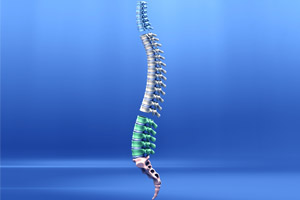 Your spine, or backbone, is the primary physical support for your body. The spine is composed of 33 separate vertebrae, which are flexible and permit standing, bending over, and twisting. The bony vertebrae encase and protect the spinal cord, which is connected directly to the brainstem. A healthy spine is flexible and strong, and it contributes to strong muscles and bones. However, injury, strain or disease can cause problems with the spine such as pain, inflammation and restricted movement.
Your spine, or backbone, is the primary physical support for your body. The spine is composed of 33 separate vertebrae, which are flexible and permit standing, bending over, and twisting. The bony vertebrae encase and protect the spinal cord, which is connected directly to the brainstem. A healthy spine is flexible and strong, and it contributes to strong muscles and bones. However, injury, strain or disease can cause problems with the spine such as pain, inflammation and restricted movement.
The spine develops from infancy into adulthood, gradually adapting itself from a C-shape, which is suitable for crawling, to an S-shape, which is the natural shape for two-legged walking. The natural curves in the spine serve to cushion impact from movement, absorb shock, preserve balance, and allow range of motion.
The three main curves in the spine are known as the cervical curve (the neck region), the thoracic curve (the upper back) and the lumbar curve (the lower back). There are 7 cervical vertebrae, 12 thoracic vertebrae, 5 lumbar, 5 sacral and 4 coccygeal. The sacral and coccygeal are the lowest vertebrae in the spine, below the lumbar area. Good muscle tone is important to help maintain proper posture and spinal alignment. It is also important for us to put effort into maintaining proper posture by training our bodies to walk, stand, lie, and sit such that the lowest possible amount of strain is placed on our spine, muscles, and ligaments.
Twenty-four of the vertebrae in your spine are moveable. They are cushioned by intervertebral discs which act like coiled springs. They are fluid filled and, as we age, become more brittle, causing us to get shorter. Osteoporosis, a common condition related to aging, as well as injury and strain, can cause spinal discs to herniate or bulge. This condition can cause significant back pain.
Damage to the spinal cord can cause numbness and loss of motor function. Injury to the cervical area can cause tetraplegia (also known as quadriplegia), while injury to the thoracic or lumbar area may result in paraplegia, or loss of the use of the legs and trunk.
There are several common spinal disorders. Lordosis, also known as sway back, occurs when there is abnormal forward curvature of the lumbar spine. Those who have abnormal curvature of the thoracic curve have kyphosis, or hunchback. Scoliosis occurs when there is a mild side-to-side curvature in the spine. Slight curves of less than 20 degrees do not usually present health or medical problems. Moderate curves usually need treatment because they can significantly limit physical activity.














